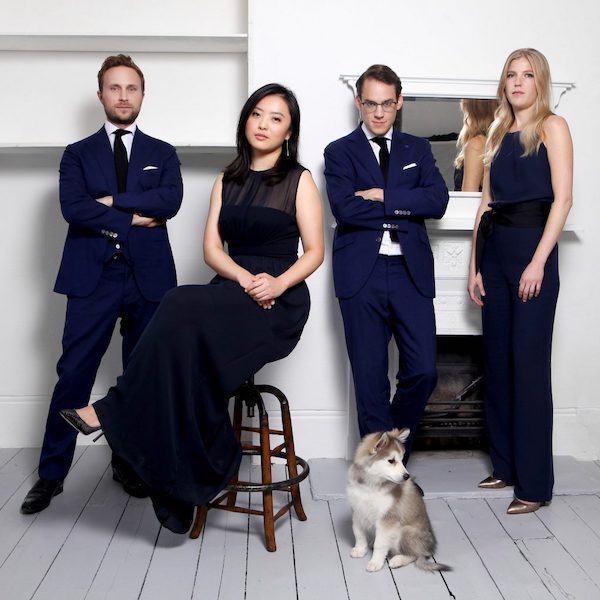Doric Quartet illuminates Haydn and Mendelssohn for Candlelight Society

The Doric String Quartet performed in Columbia Saturday night for the Candlelight Concert Society. Photo: George Garnier
The Doric String Quartet, formed in 1998, graced the stage of the Horowitz Visual and Performing Arts Center in Columbia on Saturday night. The group has two new members on the roster since its last visit to Washington, at the Phillips Collection in 2012. If anything, the new formation sounded more balanced and refined in this selection of works by Haydn, Britten, and Mendelssohn presented by the Candlelight Concert Society.
It is not always easy to make Haydn come to life off the page, and the Doric rendition of the String Quartet in B-Flat Major, Op. 33, no. 4 did just that. The group’s Haydn sound is contained and elegant, moving as one through the many gradations of volume, rhythmic fits and starts, and contrasts with unity. Alex Redington produced a svelte tone on the first violin part, with minimal vibrato that kept the focus on the center of the pitch.
Likewise, John Myerscough kept the cello part delicate and precise, helping to make the gently paced Scherzo jolly. The slow movement, however, was the high point of this quartet, again with Redington’s demure sound crowning an exquisitely balanced ensemble.
The finale, impish and light of touch, almost got away from the quartet, because of some slight rushing ahead of the beat. Violist Hélène Clément, who joined the quartet in 2013, and second violinist Ying Xue, formerly of the Parker Quartet who joined Doric last year, sawed furiously together in the minor section of this movement. It was capped by a charming pizzicato coda, played with cool humor.
Britten is the only composer on the program not yet recorded by the Doric String Quartet for the Chandos label. They approached his String Quartet No. 3, the composer’s final work, with maximum drama, telling a vivid story through sonorities and textures. The two newest members had the most beautiful moment in the first movement, “Duets,” but the group’s sound turned strident in the loud sections of the second movement, “Ostinato.”
Redington played the first violin part with chilly confidence in the third movement, accompanied first by cello, then viola, then second violin, rising up gradually to reach the first violin in range. Shortly after the second violin reached a unison with the first violin, the piece exploded into more expressionistic sounds, coalescing into high harmonics in the stratosphere around the first violinist’s solo line.
The fourth movement, “Burlesque,” featured Redington’s husky sound on the G string, followed by a scratchy danse macabre. Woody viola solos in the fifth movement, played by Clément on the 1843 Guissani viola once given by Frank Bridge to Britten himself, accompanied a solemn march that moved implacably to the quartet’s conclusion.
In many ways the last work, Mendelssohn’s String Quartet in E Minor, Op. 44, no. 2, was the evening’s high point. The four musicians found a quietly romantic intensity in this piece, mellow and yet roiling beneath the surface until a restless motif of running notes took over the first movement. The second movement was an equally anguished Scherzo, with a motif of repeated notes buzzing brilliantly through the piece. Airy and light-filled, the movement’s predominantly staccato attacks were all perfectly tuned.
The third movement was once again the first violinist’s show, his soaring solo line limpid of tone, with only the cello getting a piece of the action toward the end. Even in the finale, with its romantic tumult, the musicians focused on interior anguish rather than sheer volume, keeping most of the muscle in reserve. A single encore made a further case for the group’s strength in Haydn, the languid, perfectly limned Andante from the String Quartet in B Minor, Op. 33, no. 1.
The Italian Saxophone Quartet plays Italian film music 3 p.m. March 31. candlelightconcerts.org


